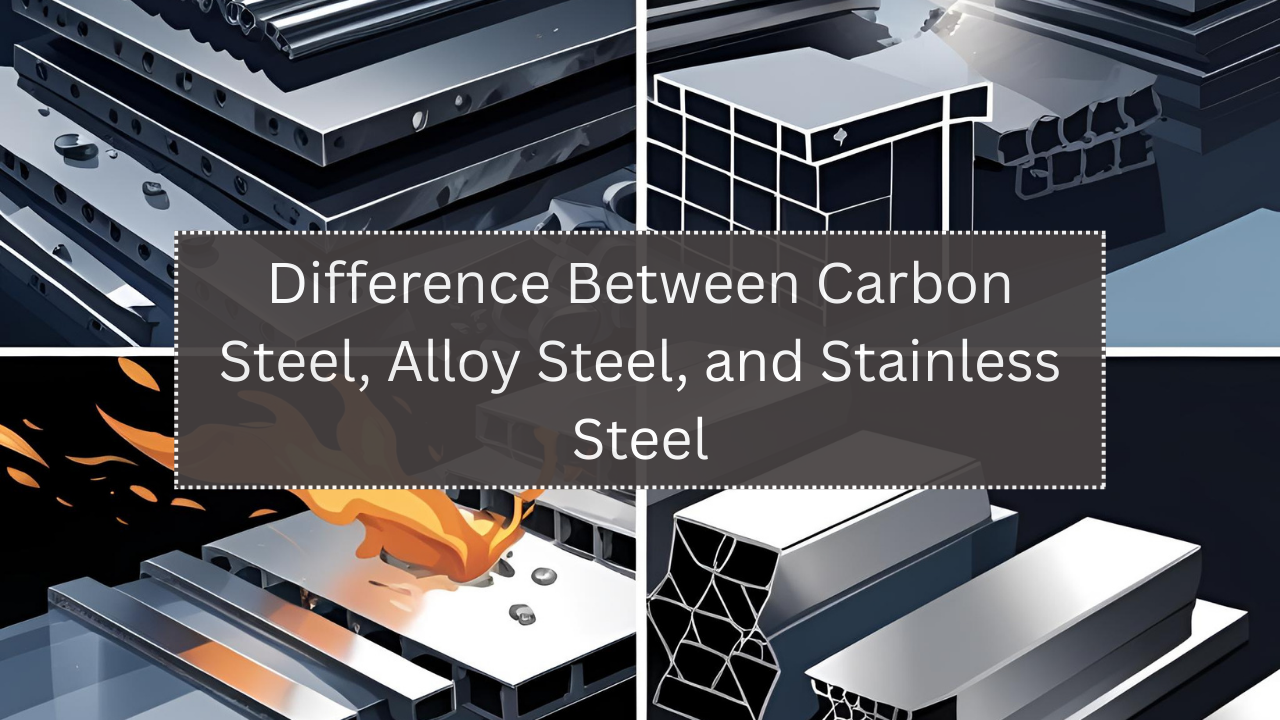Steel is one of the most widely used materials in construction, manufacturing, and engineering. However, not all steels are the same. The three major types—carbon steel, alloy steel, and stainless steel—have different compositions, properties, and applications. Understanding these differences is essential for choosing the right material for your project.
This article explores each type in detail, comparing them based on chemical composition, strength, corrosion resistance, cost, and common uses.
What is Carbon Steel?
Carbon steel is primarily made from iron and carbon. It contains very small amounts of other elements. Based on the amount of carbon, it is divided into three subcategories:
- Low carbon steel (mild steel)
- Medium carbon steel
- High carbon steel
Carbon steel is known for its strength and affordability but is less resistant to rust compared to other steel types.
What is Alloy Steel?
Alloy steel includes iron, carbon, and other alloying elements like chromium, nickel, molybdenum, manganese, and vanadium. These elements are added to improve mechanical properties such as hardness, toughness, and wear resistance.
The amount and type of alloying elements determine whether the alloy steel is classified as:
- Low-alloy steel
- High-alloy steel
Alloy steels are typically used in demanding environments like power plants, automotive parts, and pipelines.
What is Stainless Steel?
Stainless steel is a type of alloy steel but deserves a separate category due to its high chromium content (at least 10.5%), which gives it excellent corrosion resistance. It also often includes nickel, molybdenum, and nitrogen to improve performance in harsh conditions.
Stainless steel is widely used in kitchen appliances, surgical instruments, food processing, and construction due to its clean look and resistance to rust.
Detailed Comparison
| Property | Carbon Steel | Alloy Steel | Stainless Steel |
|---|---|---|---|
| Main Components | Iron and Carbon | Iron, Carbon, plus alloying elements | Iron, Chromium (≥10.5%), Nickel, other elements |
| Carbon Content | Up to 2.1% | Varies (usually less than carbon steel) | Low to very low |
| Corrosion Resistance | Poor (rusts easily) | Moderate (depends on alloying elements) | Excellent (due to chromium) |
| Strength | High (increases with carbon content) | Very high (can be tailored for specific needs) | High |
| Hardness | Good, especially in high carbon steel | Very good (with alloying elements like vanadium) | Moderate to high |
| Ductility | High in low carbon steel | Moderate to high depending on composition | Good |
| Weldability | Excellent (especially low carbon steel) | Moderate | Good (varies with type) |
| Cost | Cheapest among the three | Moderate to expensive | Expensive |
| Common Uses | Construction, pipelines, tools | Automotive, power generation, machinery | Cutlery, medical devices, architecture |
Strength and Performance
- Carbon steel becomes stronger as the carbon content increases, but it also becomes more brittle.
- Alloy steel can be engineered for specific strengths and applications, offering a better balance between strength and flexibility.
- Stainless steel offers good strength along with excellent corrosion resistance, making it ideal for both aesthetic and functional uses.
Corrosion Resistance
| Steel Type | Corrosion Resistance |
|---|---|
| Carbon Steel | Poor (needs coating or painting) |
| Alloy Steel | Moderate (some alloying elements offer protection) |
| Stainless Steel | Excellent (forms a passive layer of chromium oxide) |
- Carbon steel will rust if not protected by paint or coating.
- Alloy steel can resist corrosion better than carbon steel but depends on the specific alloys used.
- Stainless steel naturally resists rust and stains because of its chromium content, which forms a protective layer on the surface.
Applications of Each Steel Type
| Steel Type | Common Applications |
|---|---|
| Carbon Steel | Structural beams, pipelines, rebar, bolts, knives, simple tools |
| Alloy Steel | Gears, shafts, axles, aerospace parts, oil and gas components |
| Stainless Steel | Kitchen utensils, surgical tools, marine equipment, food processing machinery |
Each steel type fits specific industries:
- Carbon steel is used when strength and cost-efficiency are priorities.
- Alloy steel is chosen for durability and performance in extreme environments.
- Stainless steel is selected when hygiene and corrosion resistance are crucial.
Appearance and Maintenance
| Steel Type | Surface Appearance | Maintenance Required |
|---|---|---|
| Carbon Steel | Dull or matte, prone to rust | Needs painting or oiling |
| Alloy Steel | Varies with alloy and finish | Periodic maintenance needed |
| Stainless Steel | Shiny, smooth, attractive | Minimal (just regular cleaning) |
- Stainless steel is often chosen for visible applications due to its polished look.
- Carbon and alloy steels may require coating or treatment for appearance and protection.
Cost Comparison
| Steel Type | Relative Cost | Why the Difference? |
|---|---|---|
| Carbon Steel | Low | Simple composition and low processing cost |
| Alloy Steel | Medium to High | More expensive elements and heat treatments |
| Stainless Steel | High | Chromium and nickel content increases production cost |
- Carbon steel is best for budget-conscious projects.
- Stainless steel may cost more initially but saves money on maintenance and replacement over time.
Advantages and Disadvantages
| Steel Type | Advantages | Disadvantages |
|---|---|---|
| Carbon Steel | Strong, affordable, easy to weld and shape | Rusts easily, limited corrosion resistance |
| Alloy Steel | Customizable properties, stronger than carbon steel | Higher cost, more complex processing |
| Stainless Steel | Rust-proof, attractive finish, long-lasting | Expensive, harder to machine |
Which One Should You Choose?
The choice depends on your project requirements:
- Choose carbon steel if you need strength at a low cost and can handle regular maintenance.
- Choose alloy steel if you require enhanced mechanical properties or are working in high-stress environments.
- Choose stainless steel if you want long-term durability with minimal maintenance, especially in wet or corrosive environments.
Wrapping Up
Steel comes in many forms, and understanding the differences between carbon steel, alloy steel, and stainless steel helps ensure you select the right type for your needs. Each has its advantages, costs, and ideal applications. Whether you are building a bridge, designing a car, or manufacturing kitchen appliances, the correct steel type can make your project more efficient, durable, and cost-effective.
Let your choice be guided by the material’s properties, environment, and budget to achieve the best performance.

